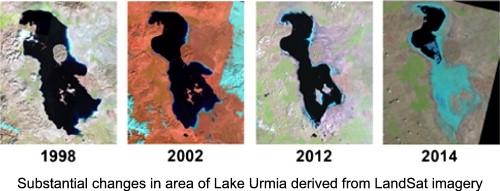New research published in Journal of Great Lakes Research shows Iran’s most famous lake has shrunk by nearly 90% this September. The popular story is presented by The Guardian. Ali Mirchi, Kaveh Madani and Amir AghaKouchak, coauthors of the research paper, urge action.
“In the late 1990s, Lake Urmia, in north-western Iran, was twice as large as Luxembourg and the largest salt-water lake in the Middle East. Since then it has shrunk substantially, and was sliced in half in 2008, with consequences uncertain to this day, by a 15-km causeway designed to shorten the travel time between the cities of Urmia and Tabriz.
Historically, the lake attracted migratory birds including flamingos, pelicans, ducks and egrets. Its drying up, or desiccation, is undermining the local food web, especially by destroying one of the world’s largest natural habitats of the brine shrimp Artemia, a hardy species that can tolerate salinity levels of 340 grams per litre, more than eight times saltier than ocean water.
Effects on humans are perhaps even more complicated. The tourism sector has clearly lost out. While the lake once attracted visitors from near and far, some believing in its therapeutic properties, Urmia has turned into a vast salt-white barren land with beached boats serving as a striking image of what the future may hold.
Given the far-reaching socio-economic effects, and human health impacts that may extend beyond Iran’s borders, Lake Urmia’s collapse requires active involvement of international organisations that can provide expertise and financial resources.”

